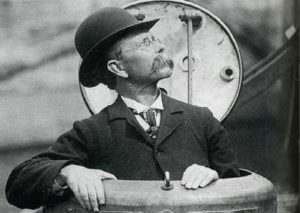
New Delhi. 17 March 2020. It was a red letter day in military history especially naval history when on 17th March 1898, St Patrick’s Day , John Philip Holland successfully test ran the first modern submarine off Staten Island, submerging for 1 hour 40 minutes.
It was an Irish story which became a US one and changed the face of naval warfare forever. John Philip Holland developed the first submarine to ever be formally commissioned by the U.S. Navy. His real breakthrough came by combining the lessons of the past and combining modern propulsion. Specifically, the electric motor, the electric battery, and the internal combustion engine.
John has dreamed of being a sailor, but his destiny had other ideas. He joined the Christian Brothers in Ireland his home country at Limerick and also taught there and many other centers across Ireland, including Cork. These included the North Monastery CBS in Cork City, St. Mary’s CBS, Portlaoise, St Joseph’s CBS (Drogheda) and he was the first Mathematics teacher in Colaiste Ris (also Dundalk).
It was during this time that he began to get into submersible vessels after reading some accounts of engagements between American Civil War ships.Holland taught school until 1872 in Ireland and in 1873 emigrated to the United States. Settling in Paterson, N.J., he taught there until 1879, when, with financial support from the Irish Fenian Society (who hoped to use submarines against England), he built the Fenian Ram, a small sub that proved a limited success in a test run. In 1895 his J.P. Holland Torpedo Boat Company received a contract from the U.S. Navy to build a submarine, and in 1898 a successful Holland, the first truly practical submarine, was launched. The U.S. government ordered six more; similar orders came from England, Japan, and Russia. Holland’s final years were marked by litigation with his financial backers. One of his last inventions was an apparatus designed to enable sailors to escape from damaged submarines.
Holland’s submersible vessel considered the principal forerunner of the modern submarine, designed by John Holland for the United States Navy and accepted by the Navy in 1900. It was 53 feet (16 metres) long, displaced 74 tons, and was armed with a gun that could fire a 100-pound (45-kilogram) projectile half a mile (about 0.8 kilometre). Its hull was cigar-shaped, and the tanks were flooded for submersion, two features similar to those of modern submarines. The “Holland” had an apparatus that took it to a predetermined depth and another device that kept it level. For surface cruising it was powered by a gasoline engine; this also served to turn a generator to charge the batteries that provided the current for the electric motors used for underwater propulsion. The “Holland” had a surface speed of seven knots (nautical miles per hour).
Holland’s chief competitor, Simon Lake, built his first submarine, the Argonaut I, in 1894; it was powered by a gasoline engine and electric motor. This and Lake’s other early boats were intended as undersea research craft. In 1898 the Argonaut I sailed from Norfolk, Va., to New York City under its own power, predating the cruises of the French Narval and marking the first time an undersea craft operated extensively in the open sea. Lake’s second submarine was the Protector, launched in 1901.
Of the major naval powers at the turn of the century, only Britain remained indifferent toward submarines. Finally, in 1901, the Royal Navy ordered five of the Holland-design undersea craft. Germany completed its first submarine, the U-1 (for Unterseeboot 1), in 1905. This craft was 139 feet long, powered on the surface by a heavy oil engine and by an electric motor when submerged, and was armed with one torpedo tube. Thus, the stage was set for the 20th-century submarine, a craft propelled on the surface by diesel engines and underwater by battery-powered electric motors, submerging by diving planes and taking on water ballast, and armed with torpedoes for sinking enemy ships. The quarters inside these early craft were cramped, generally wet, and stank from diesel oil.
By the eve of World War I all of the major navies included submarines in their fleets, but these craft were relatively small, were considered of questionable military value, and generally were intended for coastal operations. The most significant exception to the concept of coastal activity was the German Deutschland class of merchant U-boats, each 315 feet long with two large cargo compartments. These submarines could carry 700 tons of cargo at 12- to 13-knot speeds on the surface and at seven knots submerged. The Deutschland itself became the U-155 when fitted with torpedo tubes and deck guns, and, with seven similar submarines, it served in a combat role during the latter stages of the war. In comparison, the “standard” submarine of World War I measured slightly over 200 feet in length and displaced less than 1,000 tons on the surface.
The prewar submarines generally had been armed with self-propelled torpedoes for attacking enemy ships. During the war submarines also were fitted with deck guns. This permitted them to approach enemy merchant ships on the surface and signal them to stop for searching (an early war policy) and later to sink small or unarmed ships that did not warrant expenditure of torpedoes. Most war-built submarines had one and sometimes two guns of about three- or four-inch calibre; however, several later German submarines carried 150-millimetre guns (including the Deutschland class in military configuration).
Holland died on 12 August 1914 in Newark, N.J., U.S. the city which he made his home after coming to US from his native country Ireland. It was fifteen days after the World War I began and the navies of the world used his invention to keep their waters safe.
Information courtesy Britannica






























































































































